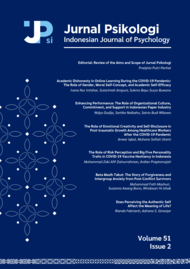Pemahaman Peneliti Psikologi mengenai Besaran Sampel: Data dan Simulasi
Wisnu Wiradhany(1*), Krisna Adiasto(2), Jony Eko Yulianto(3), Indra Yohanes Kiling(4)
(1) University of Groningen
(2) Radboud University
(3) Ciputra University
(4) University of Adelaide
(*) Corresponding Author
Abstract
Keywords
Full Text:
PDFReferences
Attali, Y., & Bar-Hillel, M. (2003). Guess where: The position of correct answers in multiple-choice test items as a psychometric variable. Journal of Educational Measurement, 40(2), 109–128. doi: 10.1111/j.1745-3984.2003.tb01099.x
Badenes-Ribera, L., Frias-Navarro, D., Iotti, B., Bonilla-Campos, A., & Longobardi, C. (2016). Misconceptions of the p-value among Chilean and Italian academic psychologists. Frontiers in Psychology, 7(August), 1247. doi: 10.3389/fpsyg.2016.01247
Badenes-Ribera, L., Frías-Navarro, D., Monterde-I-Bort, H., & Pascual-Soler, M. (2015). Interpretation of the p-value: A national survey study in academic psychologists from Spain. Psicothema, 27(3), 290–295. doi: 10.7334/psicothema2014.283
Bakker, M., Hartgerink, C. H. J., Wicherts, J. M., & van der Maas, H. L. J. (2016). Researchers intuitions about power in psychological research. Psychological Science. doi: 10.1177/0956797616647519
Bakker, M., van Dijk, A., & Wicherts, J. M. (2012). The rules of the game called psychological science. Perspectives on Psychological Science, 7(6), 543–554. doi: 10.1177/1745691612459060
Button, K. S., Ioannidis, J. P. A., Mokrysz, C., Nosek, B. A., Flint, J., Robinson, E. S. J., & Munafò, M. R. (2013). Power failure: Why small sample size undermines the reliability of neuroscience. Nature Reviews. Neuroscience, 14(5), 365–76. doi: 10.1038/nrn3475
Champely, S. (2009). Package “ pwr .” October, 1–21.
Cohen, J. (1988). Statistical power analysis for the behavioral sciences. Statistical Power Analysis for the Behavioral Sciences, 2. doi: 10.1234/12345678
Cohen, J. (1990). Things I have learned (so far). American Psychologist. Retrieved from http://psycnet.apa.org/psycinfo/1991-11596-001
Cohen, J. (1992a). A power primer. Psychological Bulletin, 112(1), 155–159. doi: 10.1037/0033-2909.112.1.155
Cohen, J. (1992b). Statistical power analysis. Psychological Science. doi: 10.1111/1467-8721.ep10768783
Dufresne, R. J., Leonard, W. J., & Gerace, W. J. (2002). Making sense of students ’ answers to multiple-choice questions. The Physics Teacher, 40(March), 174–180.
Durlak, J. A. (2009). How to select, calculate, and interpret effect sizes. Journal of Pediatric Psychology, 34(9), 917–928. doi: 10.1093/jpepsy/jsp004
Gigerenzer, G. (2004). Mindless statistics. Journal of Socio-Economics, 33(5), 587–606. doi: 10.1016/j.socec.2004.09.033
Hoekstra, R., Morey, R. D., Rouder, J. N., & Wagenmakers, E.-J. (2014). Robust misinterpretation of confidence intervals. Psychonomic Bulletin & Review, 21(5), 1157–1164. doi: 10.3758/s13423-013-0572-3
Ioannidis, J. P. A. (2005). Why most published research findings are false. PLoS Medicine, 2(8), e124. doi: 10.1371/journal.pmed.0020124
Ioannidis, J. P. A. (2008). Why most discovered true associations are inflated. Epidemiology, 19(5), 640–648. doi: 10.1097/EDE.0b013e31818131e7
Ioannidis, J. P. A., Munafò, M. R., Fusar-Poli, P., Nosek, B. A., & David, S. P. (2014). Publication and other reporting biases in cognitive sciences: Detection, prevalence, and prevention. Trends in Cognitive Sciences, 18(5), 235–241. doi: 10.1016/j.tics.2014.02.010
Ioannidis, J. P. A., Ntzani, E. E., Trikalinos, T. A., & Contopoulos-Ioannidis, D. G. (2001). Replication validity of genetic association studies. Nature Genetics, 29, 306–309. doi: 10.1038/ng749
Lakens, D. (2013). Calculating and reporting effect sizes to facilitate cumulative science: A practical primer for t-tests and ANOVAs. Frontiers in Psychology, 4(NOV), 1–12. doi: 10.3389/fpsyg.2013.00863
Lindsay, S. (2015). Replication in Psychological Science. Psychological Science, 26(12), 1827–1832. doi: 10.1177/0956797615616374
Open Science Collaboration. (2015). Estimating the reproducibility of psychological science. Science, 349(6251), aac4716-aac4716. doi: 10.1126/science.aac4716
Pluye, P., & Hong, Q. N. (2014). Combining the power of stories and the power of numbers: Mixed methods research and mixed studies reviews. Annual Review of Public Health, 35(1), 29–45. doi: 10.1146/annurev-publhealth-032013-182440
R Core team. (2015). A language and environment for statistical computing. R Foundation for Statistical Computing , Vienna, Austria. ISBN 3-900051-07-0, URL http://www.R-Project.org/. Retrieved from http://www.mendeley.com/research/r-language-environment-statistical-computing-96/%5Cnpapers2://publication/uuid/A1207DAB-22D3-4A04-82FB-D4DD5AD57C28
Rouder, J. N. (2014). Optional stopping: No problem for Bayesians. Psychonomic Bulletin & Review, 21(2), 301–8. doi: 10.3758/s13423-014-0595-4
Simmons, J. P., Nelson, L. D., & Simonsohn, U. (2011). False-positive psychology: Undisclosed flexibility in data collection and analysis allows presenting anything as significant. Psychological Science, 22(11), 1359–1366. doi: 10.1177/0956797611417632
Simonsohn, U., Nelson, L. D., & Simmons, J. P. (2014). P-curve: A key to the file-drawer. Journal of Experimental Psychology: General, 143(2), 534–547. doi: 10.1037/a0033242
Wagenmakers, E.-J. (2007). A practical solution to the pervasive problems of p values. Psychonomic Bulletin & Review, 14(5), 779–804. doi: 10.3758/BF03194105
Wasserstein, R. L., & Lazar, N. A. (2016). The ASA’s statement on p -values: Context, process, and purpose. The American Statistician, 70(2), 129–133. doi: 10.1080/00031305.2016.1154108
Wickham, H. (2010). A layered grammar of graphics. Journal of Computational and Graphical Statistics, 19(1), 3–28. doi: 10.1198/jcgs.2009.07098
Article Metrics
Refbacks
- There are currently no refbacks.
Copyright (c) 2019 Jurnal Psikologi

This work is licensed under a Creative Commons Attribution-ShareAlike 4.0 International License.
Recent Issues
 |  |  |  | ||||
| Vol 51 Issue 2 (2024) Page 120-230 | Vol 51 Issue 1 (2024) Page 1-119 | Vol 50 Issue 3 (2023) Page 219-332 | Vol 50 Issue 2 (2023) Page 125-218 |
| Published by Faculty of Psychology, Universitas Gadjah Mada, Indonesia Building D-6th, Floor No. D-606. Jl. Sosio Humaniora No. 1, Bulaksumur Yogyakarta, 55281 Email: jurnalpsikologi@ugm.ac.id Phone/whatsApp: +6281125210175 |











